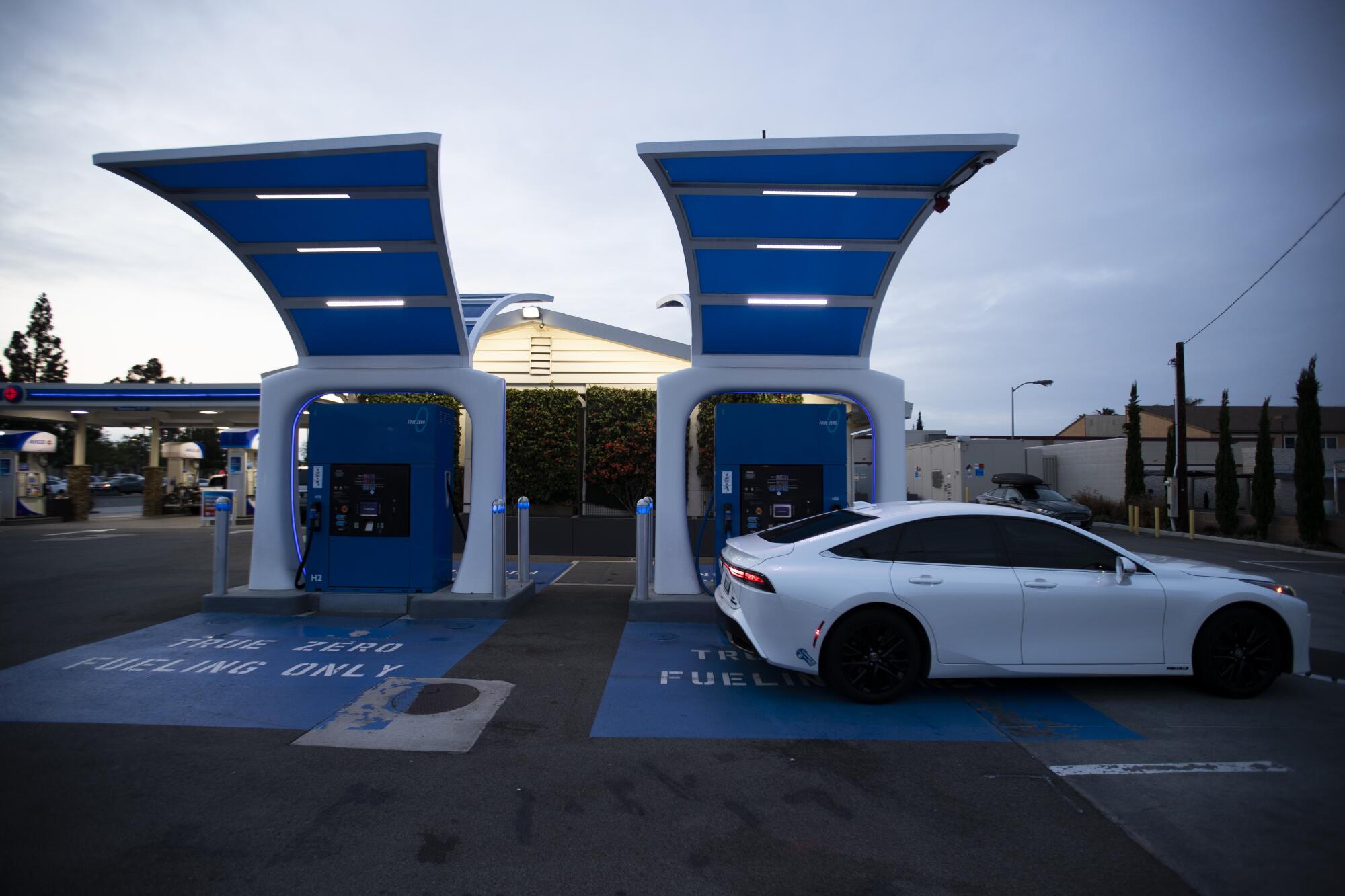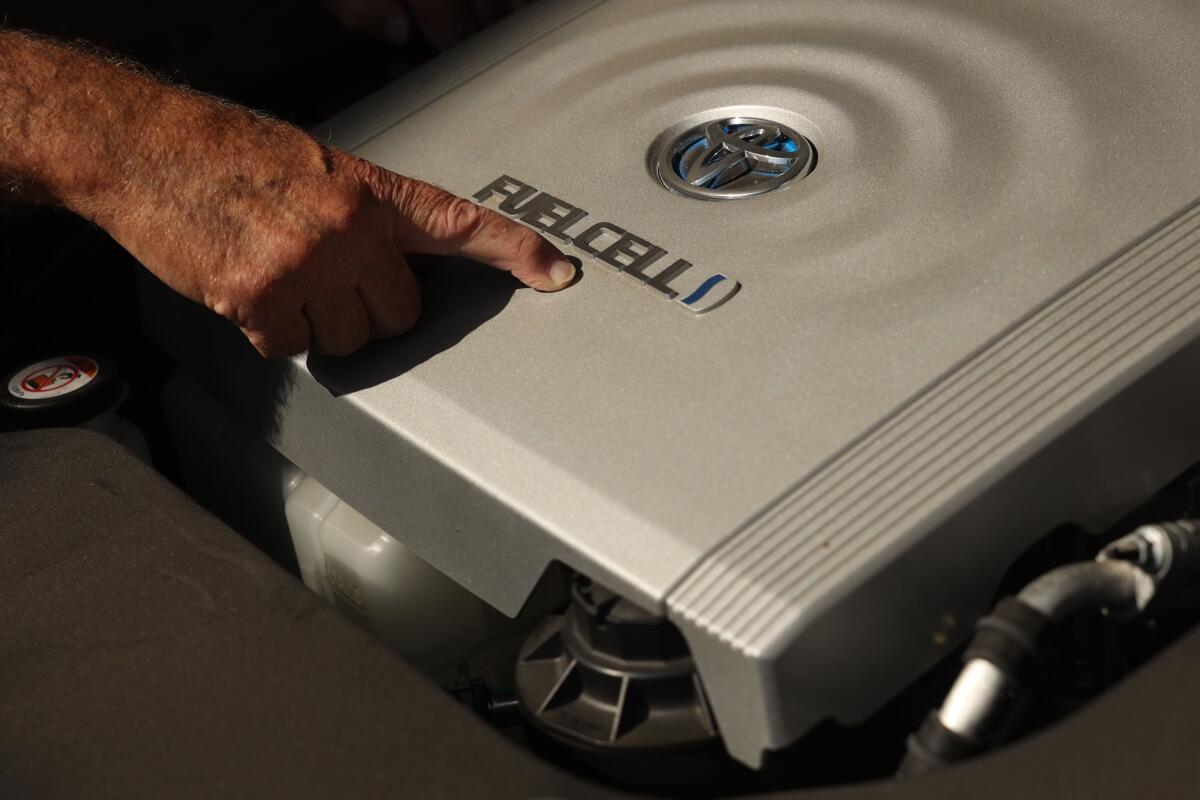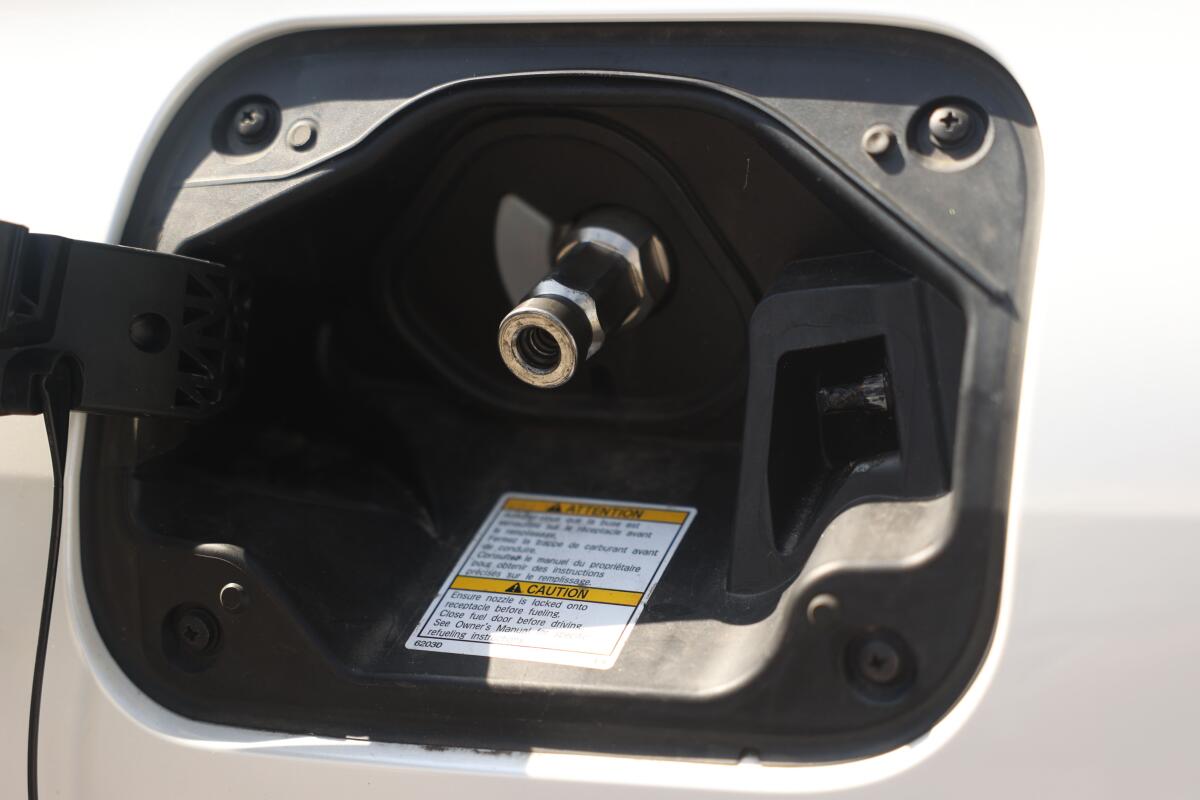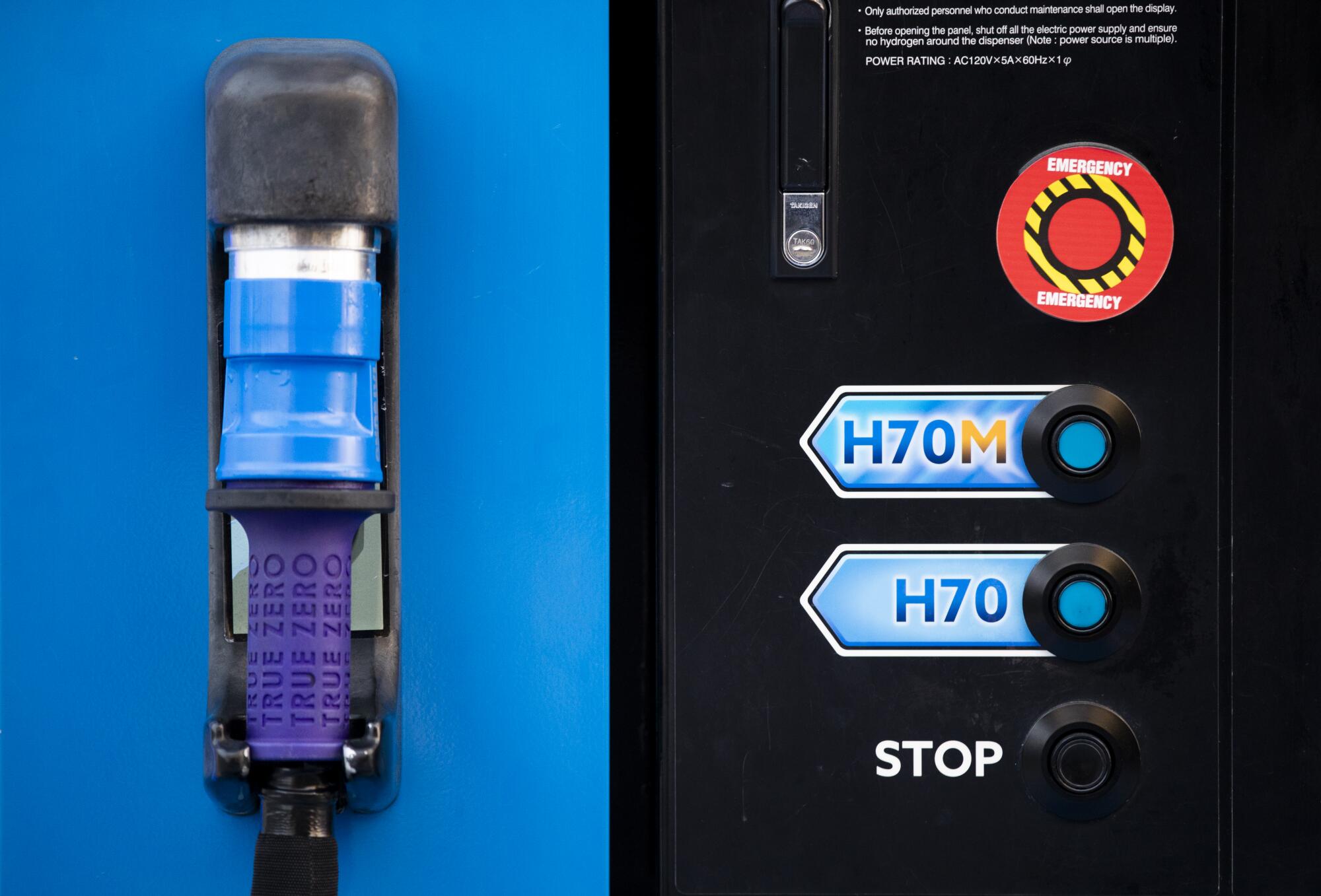When he first bought his Toyota Mirai in 2022, Ryan Kiskis was a happy man. He loved the idea of applying cutting edge hydrogen fuel cell technology to environmental consciousness.
“It’s a great car,” he said. “My background is an engineer, I’m a huge automotive fan, and I felt the the world was finally catching up with what we have to do” to cut greenhouse gases.
Then reality crashed in.
Aggressive and impactful reporting on climate change, the environment, health and science.
He soon learned that hydrogen refueling stations are scarce and reliably unreliable. He learned that apps to identify broken stations hand out bad information. He learned that the state of California, which is funding the station buildout, is far behind schedule — 200 stations were supposed to be up and running by 2025, but only 54 exist. And since Kiskis bought his car, the price of hydrogen has more than doubled, currently the equivalent of $15 a gallon of gasoline.
With fueling so expensive and stations so undependable, Kiskis — who lives in Pacific Palisades and works at Google in Playa Vista — drives a gasoline Jeep for everything but short trips around the neighborhood.
“I’ve got a great car that sits in the driveway,” he said.
Bryan Caluwe can relate. The retired Santa Monican bought a Mirai in 2022. He likes his car too. “But it’s been a total inconvenience.” Hydrogen stations “are either down for mechanical reasons, or they’re out of fuel, or, in the case of Shell, they’ve rolled up the carpet and gone home.”
And don’t get Irving Alden started. He runs a commercial print shop in North Hollywood. He leases a Mirai. He too loves the car. But the refueling system? “It’s a frickin’ joke.”
The three are part of a class action lawsuit filed in July against Toyota. They claim that Toyota salespeople misled them about the sorry state of California’s hydrogen refueling system. “They were told the stations were convenient and readily available,” said lawyer Nilofar Nouri of Beverly Hills Trial Attorneys. “That turned out to be far from reality.” The class action now amounts to two dozen plaintiffs and growing, Nouri said. “We have thousands of these individuals in California who are stuck with this vehicle.”
Kiskis believes Toyota sales staff duped him — but says, “I’m just as irritated with the state of California” for poor oversight of the program it’s funding.
Toyota told The Times it is “committed to customer satisfaction and will continue to evaluate how we can best support our customers. We will respond to the allegations in this lawsuit in the appropriate forum.”
Hyundai also sells a fuel cell car in California called the Nexo, and although the the suit is aimed only at Toyota, the hydrogen station situation affects Hyundai too. Hyundai said it “shares the concern regarding the current state of the hydrogen fueling infrastructure in California” and that “we are also closely collaborating with government agencies such as the California Energy Commission, which provided a majority of the funding for public refueling stations.”
It’s more bad news for California political leaders’ attempts to turn the state carbon neutral by 2045. Zero-emission vehicles are key to that goal, but the state is already struggling with a bungled rollout of public charging stations. The top reason car buyers give for not considering EVs is lack of availability for public chargers, according to a recent J.D. Power market survey, which concluded that “concerns about public charging infrastructure are only getting worse.”

A Toyota Mirai fills up at a True Zero hydrogen station in Fountain Valley.
(Allen J. Schaben / Los Angeles Times)
Fuel cell cars are a key pillar in the state’s decarbonization plan. The California Air Resources Board has projected that more than 10% of new cars sold in 2035 will be fuel cell vehicles, growing to more than 20% annually by 2045. That’s a lot of cars — 1.78 million new vehicles were sold in California last year.
Since hydrogen station growth has stalled and hydrogen prices exploded, fuel cell sales have stalled too. In the first half of 2023, 1,765 such cars were sold or leased. This year’s first half: 298.
The owners rarely complain about their cars. It’s the hydrogen refueling system that gives them grief. As early as 2006, 20 hydrogen stations had been installed in California. Today, more than $260 million of state money later, there are 54. They’re clustered in greater L.A. and in the Bay Area, with a single station in between, along Interstate 5 at Harris Ranch. (Once, after finding the Harris Ranch station closed on his way back to L.A., Caluwe said, he nearly ran out of fuel and had to be towed over the Grapevine.)
Who built the hydrogen stations in California? Not the carmakers. Just as they didn’t construct the nation’s gasoline station system, they’re not building out the hydrogen system. That falls to hydrogen station operators Iwatani, Air Products and True Zero, which is owned by FirstElement Fuel.
The state money awarded to those companies is pulled from transportation fees paid by California vehicle owners and from revenue produced by the state’s carbon-credit market. Fueling station companies did contribute some money of their own, but the vast bulk of the cash was paid by the state.
1

2

1. Fuel cell cars work by combining hydrogen fuel with oxygen in the air to make electricity, which powers an electric motor, which makes the car go. 2. Refueling a hydrogen fuel cell car is more like filling up at a gas station than recharging an EV. (Michael Blackshire / Los Angeles Times)
Fuel cell cars are a pillar of the state’s ambitious climate goals. Like battery electric cars, they emit no greenhouse gases. Basically, they work like this: The fuel cell combines hydrogen fuel with airborne oxygen to create electricity, in turn driving an electric motor that turns the wheels of the car. Although hydrogen fuel is made through methods that range from clean to dirty, the only emission from the cars themselves is water vapor.
Although battery electric cars are far more popular, fuel cell vehicles boast some advantages. The full tank range is 350 to 400 miles. A fill-up usually takes no more than five or 10 minutes, compared with much longer waits at public EV charging stations.
But unlike electric vehicles, you can’t fill up at home. You have to travel to a dedicated fueling station. The state planned to have nearly 200 stations installed by now, but only a quarter are up and (sometimes) working.
Nearly 18,000 fuel cell cars have been bought or leased to date in California. Since 2020, more than 10,000 fuel cell cars were registered and hit California highways. Over those years, the net number of available hydrogen stations increased by a paltry two. (One California station operator dropped out of the market earlier this year: International oil giant Shell had installed seven hydrogen stations in California with more on the way, but earlier this year it shut them down and refunded the $40-million-plus in grant money from the state.)
So far, the state’s 54 hydrogen stations have cost Californians nearly $5 million apiece.
It wasn’t supposed to be this way. Former Gov. Arnold Schwarzenegger pumped up the idea of hydrogen cars in his first term. The state began to subsidize purchase of fuel cell cars. Under Gov. Jerry Brown, the 200 state-subsidized stations were planned, after which, it was stated, the free market would take over and hydrogen stations would proliferate.
“More cars would mean more demand for retail [stations], retail would attract more cars, in a virtuous circle,” said State Sen. Josh Newman (D-Fullerton), who owns a Mirai.
The California Energy Commission is in charge of hydrogen station funding. The commission, Newman said, “did not follow through on levels of funding that would maintain that balance.”
While he’s not disputing the accounts of the class action litigants, Newman said, “I think Toyota has been mistreated as badly as anybody.” Toyota and Hyundai (and, for a few years, Honda) were depending on a robust station build-out to encourage sales.
The carmakers give new fuel cell owners a debit card worth $15,000 of fuel, Newman noted, another rich incentive to go hydrogen. But the steep hike in hydrogen prices has degraded the benefit’s value — by more than half, Caluwe noted.

Pump nozzle and pressure buttons on a True Zero hydrogen dispenser.
(Allen J. Schaben/Los Angeles Times)
The energy commission declined requests for an interview with chair David Hoschild or commissioner Patty Monahan. In a prepared statement, the commission said improving the reliability and performance of hydrogen stations is “a current priority.” Furthermore, the commission “will continue to track the market and make informed decisions for both electric and hydrogen infrastructure. In making those decisions the [commission] will continue to conduct analysis, publish reports [and] monitor vehicle model availability and customer uptake and interest by the private market to build and invest in hydrogen stations.”
Earlier this year, the energy commission granted an extra $9.4 million to FirstElement and Itawani for operations and maintenance at the company’s stations. (Those companies did not responded to requests to comment.)
Unlike previous such grants, these insist on 95% uptime performance. The commission has yet to define how the 95% figure will be determined, and has not spelled out any consequences should the requirement not be met.


